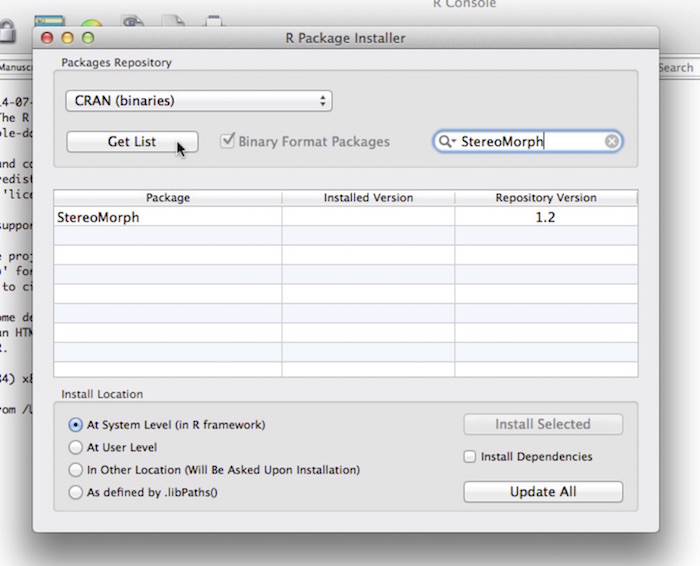R Location Of Packages
The release of the leaflet package in 2015 revolutionized interactive web map creation from within R and a number of packages have built on these foundations adding new features (e.g., leaflet.extras) and making the creation of web maps as simple as creating static maps (e.g., mapview and tmap). This section illustrates each approach in the. R also has a default value for a directory where users can install their own R packages. On the Owens cluster, it is /R/x8664-unknown-linux-gnu-library/3.3 if the default R-3.3.2 module is loaded. This directory doesn't exist by default. The first time a user installs an R package, R will ask the user if s/he wants to use the default location.
- R Location Of Packages Us Postal Service
- R Location Of Packages Around The World
- R Package Path
- R Change Library Path
Recently, while working on the Azure Data Lake R extension, I had to figure out a good way to create a zip file containing a package together with all its dependencies. This came down to understanding where does R store and search for packages. Despite the documentation, it did require additional reading and experimentation.
First, the accompanying video:

Before getting into package search paths, let’s first figure out how does an R package look in the file system:
An R package is a folder somewhere in the file system. Above quantmod, TTR, xts and zoo are all folders each containing the corresponding package. For these packages to be found by R, the rsite folder (its absolute path, for instance c:/users/ivannp/rsite) needs to be added to R’s search path.
R’s package search path is reported by the .libPaths() function (invoked without arguments). The result is a vector of strings, each representing a path containing packages. When the user requests a package to be loaded (via require or via library), R searches for the package in each path of the list, starting with the first. If the package is found, it is loaded and the search finishes. Thus, it is important to understand how the vector of paths is build.
The last element of the path is R’s distribution library path. On Windows this could be:
This path cannot be removed. Calling .libPaths(”) (with an empty string) will remove all other entries but the library sub-directory of the distribution.
There are three environment variables which control the content of the path vector:
- R_LIBS
- R_LIBS_USER
- R_LIBS_SITE
The content of these environment variables is added to the package search path in the order listed. First R_LIBS, then R_LIBS_USER and finally R_LIBS_SITE.
If none of the three environment variables is defined, R will append a default path to the search list. This path is platform dependent. On Windows it is something like:
To avoid depending on this behavior, I typically have R_LIBS_USER set. On Windows, make sure that the path doesn’t end with slash (‘/’ or ‘’). According to .libPaths() documentation, paths ending on a slash are invalid, and R silently ignores them.
Will all this knowledge, the solution to the original problem – how to create a zip containing a package together with all its dependencies, is clear:
The above script create packages.zip containing ggplot2 and all its dependencies. A local folder packages is used in the process. That’s assuming there are no additional packages in R’s root installation.
The post Package Paths in R appeared first on Quintuitive.
Available Packages
Currently, the CRAN package repository features 17052 available packages.
Installation of Packages
Please type help('INSTALL')or help('install.packages')in R for information on how to install packages from thisrepository. The manualR Installation and Administration(also contained in the R base sources)explains the process in detail.

CRAN Task Viewsallow you to browse packages by topic and provide tools toautomatically install all packages for special areas ofinterest.Currently, 41 views are available.
R Location Of Packages Us Postal Service
Package Check Results

R Location Of Packages Around The World
All packages are tested regularly on machines runningDebian GNU/Linux,Fedora,macOS (formerly OS X), Solaris and Windows.
The results are summarized in thecheck summary (sometimings are also available).Additional details for Windows checking and building can befound in theWindowscheck summary.
Writing Your Own Packages
The manualWriting R Extensions(also contained in the R base sources) explains how to writenew packages and how to contribute them to CRAN.
Repository Policies
The manualCRAN Repository Policy[PDF]describes the policies in place for the CRAN package repository.
R Package Path
Related Directories
R Change Library Path
- Archive
- Previous versions of the packages listed above, and other packages formerly available.
- Orphaned
- Packages with no active maintainer, see the corresponding README.
- bin/windows/contrib
- Windows binaries of contributed packages
- bin/macosx/contrib
- macOS High Sierra binaries of contributed packages
- bin/macosx/el-capitan/contrib
- OS X El Capitan binaries of contributed packages